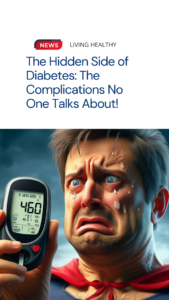Human Metapneumovirus (HMPV) has gained global attention as a respiratory virus that can cause mild to severe infections, especially in high-risk groups such as the elderly, immunocompromised individuals, and, of course, people with diabetes. In this article, we’ll explore what HMPV is, its symptoms, risks of infection, and why people with diabetes are more vulnerable to severe complications. We’ll also discuss prevention strategies and care tips for those living with diabetes.
Contents
- 1 What is HMPV (Human Metapneumovirus)?
- 2 Symptoms of HMPV
- 3 Risks of HMPV Infection in the US and Worldwide
- 4 Why Are People with Diabetes Considered High-Risk?
- 5 Treatment for HMPV
- 6 Preventing HMPV: How to Protect Yourself
- 7 How to Boost Immunity Against HMPV
- 8 What to Do If a Person with Diabetes is Infected with HMPV
- 9 Conclusion
What is HMPV (Human Metapneumovirus)?
HMPV is a respiratory virus discovered in 2001, though it has been circulating for decades. It belongs to the Paramyxoviridae family, the same family as the respiratory syncytial virus (RSV), and is one of the leading causes of respiratory infections in children, the elderly, and people with chronic health conditions like diabetes.
According to data from the World Health Organization (WHO), HMPV is responsible for approximately 5 to 10% of hospitalizations due to respiratory infections worldwide. In the United States, for example, a 2023 study published by the Centers for Disease Control and Prevention (CDC) showed that HMPV was identified in 12% of severe pneumonia cases in adults.
Symptoms of HMPV
The symptoms of HMPV can range from mild to severe, depending on the age and health status of the individual. Generally, they resemble those of a common cold or flu, including:
Cough
Nasal congestion
Sore throat
Fever
Shortness of breath
Wheezing
In more severe cases, HMPV can progress to bronchiolitis, pneumonia, or worsen pre-existing conditions like asthma or chronic obstructive pulmonary disease (COPD).
Risks of HMPV Infection in the US and Worldwide
HMPV is highly contagious and spreads through respiratory droplets released when an infected person coughs, sneezes, or talks. In the United States, the virus follows a seasonal pattern, with infection peaks during winter and spring.
Data from the CDC shows that in 2022, there was a significant increase in HMPV cases, with hospitalization rates 30% higher compared to previous years. Experts attribute this increase to the relaxation of social distancing measures post-COVID-19 pandemic, which facilitated the spread of respiratory viruses.
Globally, countries like India and Brazil have also reported HMPV outbreaks, with hospitals reporting overcrowding in intensive care units (ICUs) due to respiratory complications

Why Are People with Diabetes Considered High-Risk?
People with diabetes are among the most vulnerable to severe complications caused by HMPV. This is because diabetes can weaken the immune system, making the body less efficient at fighting infections. Additionally, high blood sugar levels can impair the function of immune cells, increasing the risk of inflammation and complications.
Possible Complications for People with Diabetes
Severe Respiratory Infections: HMPV can progress to pneumonia or bronchiolitis, conditions that require hospitalization and can be fatal for people with diabetes.
Uncontrolled Blood Sugar: Viral infections can cause blood sugar spikes, making diabetes management more challenging.
Risk of Comorbidities: People with diabetes often have other health conditions, such as heart or kidney disease, which can be worsened by HMPV.
Treatment for HMPV
Currently, there is no specific antiviral treatment for HMPV. Management of the disease focuses on relieving symptoms and providing respiratory support when necessary. Some measures include:
Rest
Adequate hydration
Use of fever and pain relievers (such as acetaminophen)
Oxygen therapy in severe cases
For people with diabetes, it’s crucial to monitor blood sugar levels and adjust medication as needed, always under medical supervision.
Preventing HMPV: How to Protect Yourself
Prevention is the best strategy to avoid HMPV infection, especially for people with diabetes. Here are some essential tips:
Wash Your Hands Frequently: Use soap and water or hand sanitizer, especially after touching public surfaces.
Avoid Contact with Sick People: Keep your distance from anyone showing respiratory symptoms.
Wear Masks in Public Places: During outbreaks, masks can reduce the risk of infection.
Boost Your Immunity: A balanced diet rich in vitamins and minerals can help improve immune response.
Keep Diabetes Under Control: Stable blood sugar levels reduce the risk of complications.
How to Boost Immunity Against HMPV
For people with diabetes, strengthening the immune system is crucial. Here are some strategies:
Healthy Eating: Consume fruits, vegetables, lean proteins, and whole grains.
Physical Exercise: Moderate activities like walking improve circulation and immune function.
Adequate Sleep: Aim for 7 to 8 hours of sleep per night to allow your body to recover.
Supplementation: In some cases, supplements like vitamin D, zinc, or probiotics may be recommended by a doctor.
What to Do If a Person with Diabetes is Infected with HMPV
If you have diabetes and suspect an HMPV infection, follow these guidelines:
Monitor Symptoms: Watch for signs of worsening, such as difficulty breathing or high fever.
Control Blood Sugar: Adjust medication as needed and keep a record of glucose levels.
Seek Medical Help: If symptoms are severe, seek medical attention immediately.
Stay Hydrated: Drink plenty of fluids to avoid dehydration.
Rest: Rest is essential for recovery.
Conclusion
HMPV is a respiratory virus that can pose a significant risk to people with diabetes due to a weakened immune system and a higher risk of complications. However, with proper preventive measures and strict diabetes management, it’s possible to reduce risks and protect your health.
Stay alert to symptoms, maintain healthy habits, and consult a doctor whenever necessary. Prevention and care are the best defenses against HMPV and other respiratory infections.





